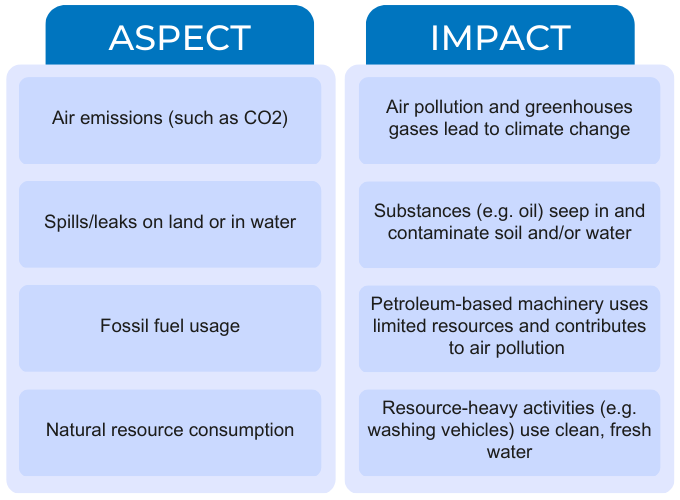How to create an environmental aspects and impacts register (5-minute read)
This is especially true if you have your sights set on ISO 14001 Environmental Management System (EMS). The certification is the most widely used EMS, with over 360,000 awarded globally.
A vital part of ISO 14001 is an environmental aspects and impacts register. But what exactly is it – and how do you complete an environmental aspects and impacts assessment in 2023?
![]() Keep reading to learn all about environmental aspects and impacts from Karen Whitby, NQA Lead Auditor.
Keep reading to learn all about environmental aspects and impacts from Karen Whitby, NQA Lead Auditor.
(Last updated: April 2023)

Why the ISO 14001 standard exists
Let’s start by talking about ISO 14001 – the international standard an environmental aspects and impacts register falls under.
ISO 14001 can be broken down into three parts:
-
Purpose – to outline the requirements for managing environmental aspects and impacts
-
E.g. fossil fuel usage (an ‘aspect’) leading to greenhouse gases (an ‘impact’)
-
-
Goals – to help a business:
-
Create, maintain, or transform its EMS
-
Remain or align with regulations and policies
-
-
Benefits – reduced waste, lowered operating costs, improved efficiency, less pollution
 ISO 14001 can also build trust with clients – not to mention keep businesses on track with legal obligations.
ISO 14001 can also build trust with clients – not to mention keep businesses on track with legal obligations.

The role of an environmental aspects and impacts register
Now that we understand the fundamentals of ISO 14001, we can explain its link to an environmental aspects and impacts register.
As we mentioned at the very start, this register is vital to ISO 14001. Conducting an environmental aspects and impacts assessment involves identifying, assessing, and prioritising the activities, products, or services of your business.
An environmental aspects and impacts register:
-
Lists the most relevant aspects
-
E.g. delivery vans powered by fossil fuels --> climate change
-
-
Maps out a plan for effectively managing the aspects
-
Allows for evaluating the business in a systematic way
.jpg) Not sure what we mean by ‘aspects’? Jump to the next section for NQA’s environmental aspects definition.
Not sure what we mean by ‘aspects’? Jump to the next section for NQA’s environmental aspects definition.

Environmental aspects vs. impacts
As the name suggests, an environmental aspects and impacts register involves ‘aspects’ and ‘impacts’.
You can find the definitions below, alongside some environmental aspects and impacts examples.
Environmental aspect definition
An environmental aspect is any part of a business’ activities that influence the environment.
So, what might an ISO 14001 environmental aspect example be?
-
Air emissions (such as CO2)
-
Land and water spills/leaks
-
Fossil fuel usage
-
Natural resource consumption
Environmental impact definition
An environmental impact is the effect a particular aspect has on the environment.
Since the two are so interlinked, here are some environmental aspects and impacts examples together:

.jpg) Think of ‘aspects’ as the cause and ‘impacts’ as the effect. Once you start considering one, the ideas will begin to flow!
Think of ‘aspects’ as the cause and ‘impacts’ as the effect. Once you start considering one, the ideas will begin to flow!
Creating an environmental aspects and impacts register
The final (and in our opinion, the most exciting) part of this article focuses on setting up an environmental aspects and impacts register.
During an environmental aspects and impacts assessment, you can:
-
Evaluate different aspects and their impacts
-
Devise a scoring system (more on that below)
-
Include legislation requirements and controls to reduce, remove and offset your impacts

Step 1: list activities, aspects, and impacts
List activities
Make a list outlining all environmental management-related activities your business takes part in.
This may include:
-
Water use (e.g. plumbing)
-
Energy use (e.g. heating and cooling system)
-
Transportation (e.g. moving X to Y location)
List aspects
Next, make a list of the aspects connected to those activities.
For instance:
-
Water is a natural resource that gets consumed
-
Energy and transportation
-
Involve fossil fuels and release CO2 emissions
List impacts
For the last part of Step 1, list the impacts associated with each aspect.
Some examples might be:
-
Water becomes unclean and/or contaminated
-
Energy and transportation
-
Contribute to air pollution and climate change
Step 2: calculate severity, likelihood, and significance
Ready for the next step of conducting an environmental aspects and impacts assessment?
Calculate severity
You need to score the severity (or ‘seriousness’) of the impact.
-
1 = not very severe; 10 = extremely severe
This may include potential damage, legislation implications, or poor publicity.
Calculate likelihood
Next up is determining the likelihood of the impact occurring.
-
1 = not very likely; 10 = extremely likely
Calculate significance
Once you have the severity and likelihood, you can focus on the significance.
-
Severity score x likelihood score = significance score
Step 3: describe controls
For Step 3, it’s time to describe controls (what you’re doing to mitigate the aspect).
Here are some examples to help:
-
Reduction in water consumption
-
Installing water meters, dual-flush toilets, and low-flow fixtures
-
-
Reduction in energy
-
Allowing remote work with Skype/Zoom and only printing when necessary
-
-
Reduction in transportation
-
Using electric vehicles for deliveries and warehouse-site transportation
-
Step 4: note legislation
Use the legislation column to note any aspect-relevant legislation or regulations.
This step is a great way to understand why each activity, aspect, and impact is included in your EMS.
Step 5: ensure compliance
Once your environmental aspects and impacts register is ready, it can be used for compliance purposes.
Not only that, but the register can help you:
-
Set business objectives and targets
-
Consider important risks
-
Grow and succeed (the greener way)

Final thoughts from NQA
Creating an environmental aspects and impacts register can seem daunting, but it doesn’t have to be.
Follow each section above to set up or improve your own register, with green-thinking benefits for years to come!
Remember: if you get lost at any point, NQA is always here to help.
 Considering the ISO 14001:2015 certification? Find out more by getting in touch with one of our friendly advisors today.
Considering the ISO 14001:2015 certification? Find out more by getting in touch with one of our friendly advisors today.
